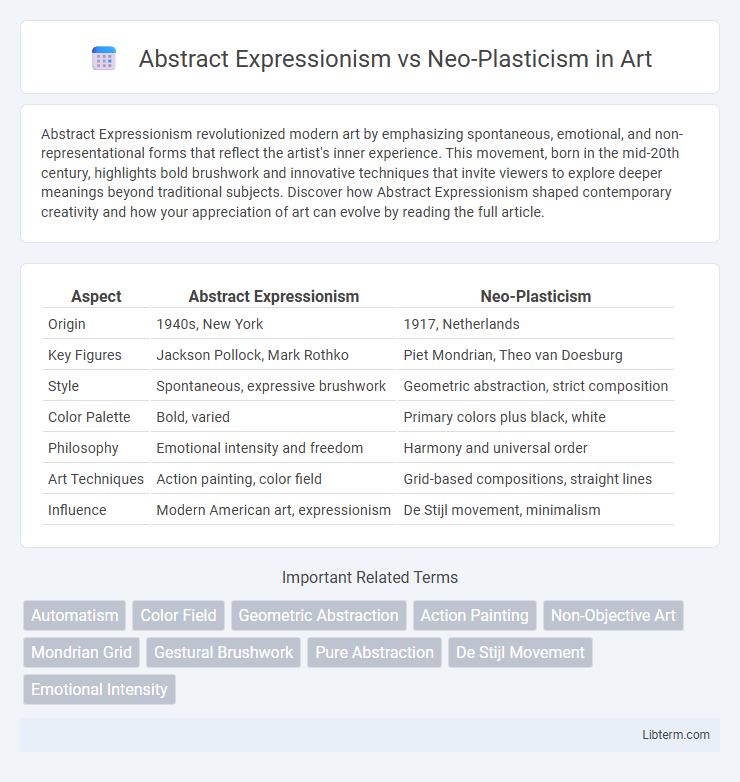Abstract Expressionism revolutionized modern art by emphasizing spontaneous, emotional, and non-representational forms that reflect the artist's inner experience. This movement, born in the mid-20th century, highlights bold brushwork and innovative techniques that invite viewers to explore deeper meanings beyond traditional subjects. Discover how Abstract Expressionism shaped contemporary creativity and how your appreciation of art can evolve by reading the full article.
Table of Comparison
| Aspect | Abstract Expressionism | Neo-Plasticism |
|---|---|---|
| Origin | 1940s, New York | 1917, Netherlands |
| Key Figures | Jackson Pollock, Mark Rothko | Piet Mondrian, Theo van Doesburg |
| Style | Spontaneous, expressive brushwork | Geometric abstraction, strict composition |
| Color Palette | Bold, varied | Primary colors plus black, white |
| Philosophy | Emotional intensity and freedom | Harmony and universal order |
| Art Techniques | Action painting, color field | Grid-based compositions, straight lines |
| Influence | Modern American art, expressionism | De Stijl movement, minimalism |
Introduction to Abstract Expressionism and Neo-Plasticism
Abstract Expressionism emerged in the 1940s as a movement characterized by spontaneous, gestural brushstrokes and an emphasis on emotional intensity, with artists like Jackson Pollock and Mark Rothko leading the charge. Neo-Plasticism, founded by Piet Mondrian in the 1910s, revolves around the use of geometric shapes, primary colors, and horizontal and vertical lines to achieve a harmonious and balanced composition. These two movements represent contrasting approaches: Abstract Expressionism prioritizes individual expression and dynamic movement, while Neo-Plasticism emphasizes order, structure, and universal aesthetic principles.
Historical Origins and Context
Abstract Expressionism emerged in the 1940s in New York as a response to the trauma of World War II, reflecting intense emotion and individualism through spontaneous, gestural brushstrokes. Neo-Plasticism, developed by Piet Mondrian in the early 20th century Netherlands, arose from the De Stijl movement and emphasized pure geometric forms and primary colors to express universal harmony. The contrasting historical contexts highlight Abstract Expressionism's focus on existential angst and personal freedom, while Neo-Plasticism sought order and balance amid the chaos of modernity.
Key Philosophical Foundations
Abstract Expressionism centers on the spontaneous, subconscious expression of the individual psyche, emphasizing emotional intensity and personal freedom in art creation. Neo-Plasticism, pioneered by Piet Mondrian, advocates for universal harmony through pure abstraction, using geometric forms and primary colors to reveal an underlying spiritual order. These contrasting philosophies highlight Abstract Expressionism's focus on subjective experience against Neo-Plasticism's pursuit of objective, rational balance.
Main Artists and Influencers
Abstract Expressionism is defined by key artists like Jackson Pollock, Mark Rothko, and Willem de Kooning, who emphasized spontaneous, dynamic brushwork and emotional intensity. Neo-Plasticism, pioneered by Piet Mondrian and Theo van Doesburg, focuses on geometric abstraction using primary colors and strict grid compositions to convey universal harmony. Both movements significantly influenced modern art but diverge in methodology, with Abstract Expressionism valuing gestural freedom and Neo-Plasticism prioritizing structured balance.
Distinctive Visual Characteristics
Abstract Expressionism features dynamic, gestural brushstrokes and vivid, often chaotic color compositions emphasizing spontaneity and emotional intensity. Neo-Plasticism employs precise geometric forms, primary colors, and a strict grid-based composition reflecting balance, harmony, and universal order. Both styles contrast through Abstract Expressionism's organic, expressive approach versus Neo-Plasticism's rational, minimalist aesthetic.
Techniques and Materials Used
Abstract Expressionism employs spontaneous, dynamic brushstrokes and thick impasto techniques using oil paints and often incorporates unconventional materials like sand or collage elements to convey intense emotional expression. Neo-Plasticism, pioneered by Piet Mondrian, emphasizes clean, straight lines and flat planes using primary colors, black, white, and gray on smooth surfaces, typically achieved with oil or acrylic on canvas. The contrast lies in Abstract Expressionism's chaotic, textural approach versus Neo-Plasticism's precise, geometric order and minimalist palette.
Role of Color and Form
Abstract Expressionism emphasizes spontaneous, bold, and dynamic use of color to convey emotional intensity, often employing gestural brushstrokes and irregular forms. Neo-Plasticism, pioneered by Piet Mondrian, prioritizes geometric precision and balance, using a limited color palette of primary colors and neutrals arranged in a strict grid of vertical and horizontal lines. The role of color in Neo-Plasticism is symbolic and structural, while in Abstract Expressionism, color functions as a direct emotional and psychological expression.
Influence on Modern Art Movements
Abstract Expressionism revolutionized modern art by emphasizing spontaneous, emotional expression and large-scale canvases, deeply influencing movements like Action Painting and Color Field Painting. Neo-Plasticism, pioneered by Piet Mondrian, introduced a systematic approach with geometric abstraction and a strict use of primary colors, impacting Minimalism and De Stijl. Both movements fundamentally shaped modern art by challenging traditional aesthetics and inspiring diverse explorations of form, color, and composition.
Cultural and Social Impact
Abstract Expressionism reshaped post-war American culture by emphasizing individual freedom and emotional intensity, resonating with a society craving personal expression after global conflict. Neo-Plasticism, through its precise geometric abstraction and utopian ideals, influenced European social thought by advocating harmony and universality amid political upheaval. Both movements challenged traditional art norms, deeply affecting cultural narratives about identity, freedom, and social order in the 20th century.
Lasting Legacy and Contemporary Relevance
Abstract Expressionism's lasting legacy is evident in its emphasis on individual emotion and spontaneity, influencing contemporary art movements that prioritize personal expression and dynamic brushwork. Neo-Plasticism's enduring relevance stems from its foundational principles of geometric abstraction and harmony, which continue to impact modern design, architecture, and minimalist art practices. Both movements contribute significantly to contemporary art discourse by shaping ongoing dialogues around form, color, and the role of subjectivity in artistic creation.
Abstract Expressionism Infographic

 libterm.com
libterm.com